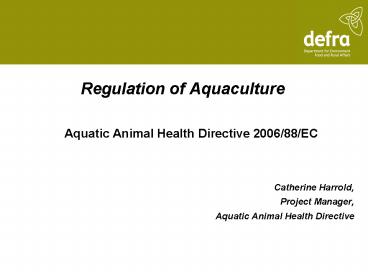Regulation of Aquaculture - PowerPoint PPT Presentation
1 / 10
Title:
Regulation of Aquaculture
Description:
Ensure we are onto them quickly. Minimise the impact of silent spread' ... Range of diseases, including: epizootic haematopoietic necrosis (EHN), viral ... – PowerPoint PPT presentation
Number of Views:117
Avg rating:3.0/5.0
Title: Regulation of Aquaculture
1
Regulation of Aquaculture
- Aquatic Animal Health Directive 2006/88/EC
- Catherine Harrold,
- Project Manager,
- Aquatic Animal Health Directive
2
What do we want to do?
- In the first place, prevent serious diseases
happening in UK - If they do happen
- Ensure we are onto them quickly
- Minimise the impact of silent spread
- Minimise the impact of controls.
- Reassure other countries that our disease status
can be relied on.
3
Why?
- Minimise the cost of disease - money, reputation
- Support industry
- Operate to common rules across EU and world
- Ensure rest of world believes in our health
status.
4
Approach
- Regulation that
- minimises spread of disease
- fosters trade and does not over-regulate business
- is accepted internationally
- takes a risk-based approach.
5
So
- Council Directive 2006/88/EC of 24 October 2006
on animal health requirements for aquaculture
animals and products thereof, and on the
prevention and control of certain diseases in
aquatic animals (L 328 24.11.2006) plus - Corrigendum (L 140 1.6.2007)
6
Implementation in England Wales
- By 7 March reply to consultation (hard copy or
fishhealth_at_Defra.gsi.gov.uk) - By 1 May regulations must be in place
- By 1 August regulations must come into force.
7
Risk/threat
- Movement of live fish
- Range of diseases, including epizootic
haematopoietic necrosis (EHN), viral haemorrhagic
septicaemia (VHS), infectious salmon anaemia
(ISA), emerging disease
8
Main features
- All fish farms (and others) must be authorised by
Fish Health Inspectorate - Trade between different areas must be certified
- Those who look after fish must notify if they
suspect theyve got one of the diseases.
9
Some difficult areasAuthorisation
- To be authorised you must
- Keep movement and mortality records
- Participate in risk-based surveillance schemes
- Implement Biosecurity Measures (Good Hygiene
Practice)
10
Questions include
- What is suspicion of disease? What is unresolved
increased mortality? - What are appropriate Biosecurity Measures? How
can FHI enforce them? - What can we do to keep business going whilst
still controlling disease outbreaks (can we make
use of compartments)































